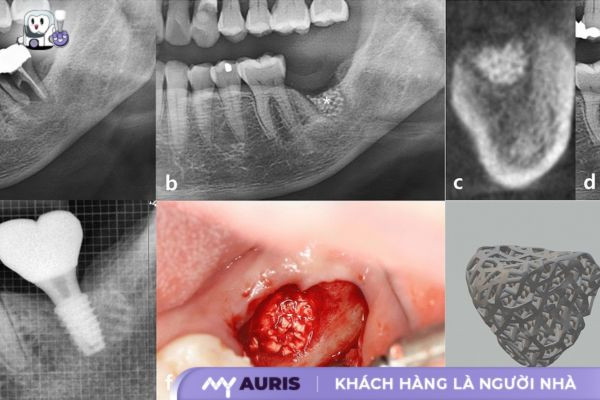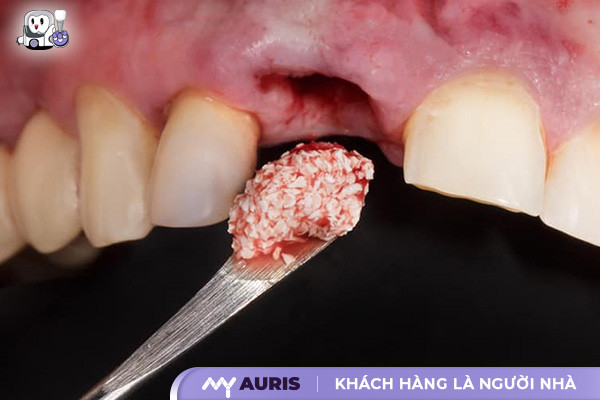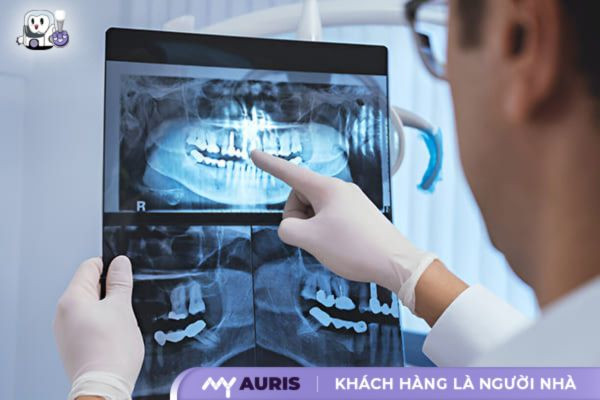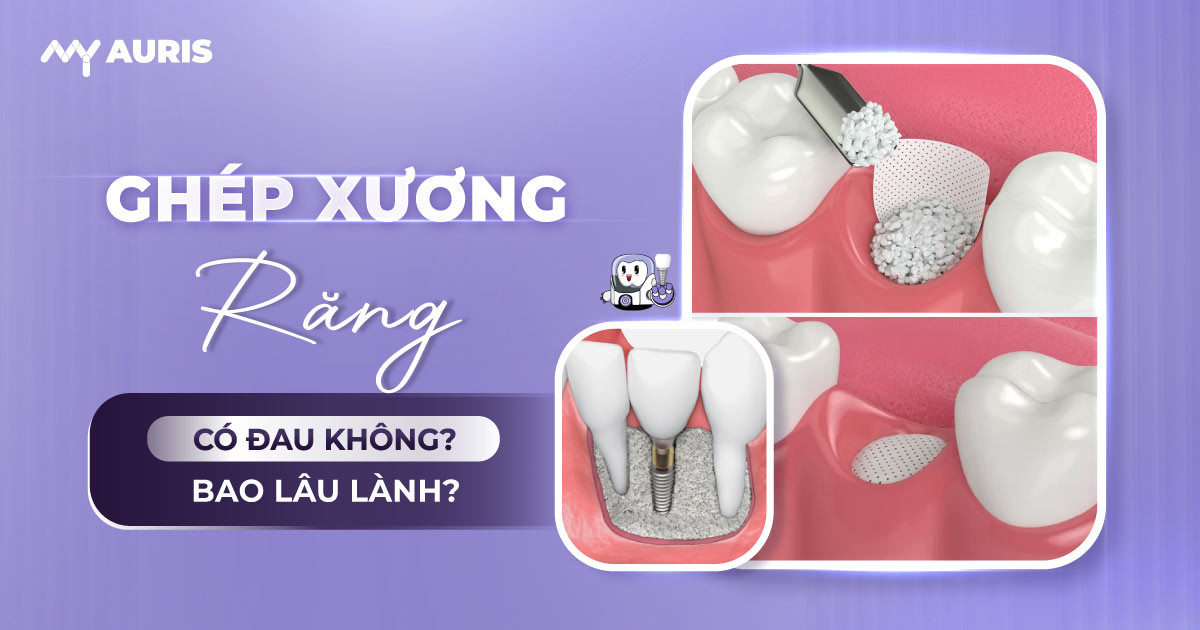Dental implant placement is an advanced tooth restoration method, but not everyone is immediately eligible for it. When experiencing jaw bone loss, patients need a jaw bone graft first to ensure the implant post has a stable foundation. So, what is the cost of bone grafting? What factors influence the price of implant placement? Let’s explore this important dental solution with My Auris Dental to be best prepared for your dental implant procedure!
What is Bone Grafting?
Bone grafting (bone graft) is a medical technique used to treat issues related to bones and joints, especially in cases of fractures, artificial joints, or bone tissue loss due to bone trauma. The doctor will choose an autograft (from the patient themselves) or an allograft (from a donor) depending on the specific condition.
This method is typically performed by implanting bone into the deficient area, supporting the process of healing and bone tissue regeneration. In some cases, the doctor may use bone tissue from other parts of the body or from a donor. Bone grafts can be used as free grafts or with accompanying blood vessels, connected using microsurgical techniques, which enhances the bone’s adaptability and recovery.

Is Artificial Bone Grafting Mandatory in Implant Placement?
In dental implant placement, bone membrane grafting is not a mandatory step in all cases. It is only indicated by the doctor when the patient’s jaw bone does not meet the standards for density and volume, to ensure the stability of the implant post.
The bone membrane grafting process is often combined with artificial bone grafting to promote bone integration, making the grafted area more stable and supporting the implant surgery for the best results. Furthermore, this technique also helps prevent jaw bone loss, ensuring the long-term durability of the dental implant.
Types of Bone Membranes Used in Implant Placement
Resorbable Bone Membrane
Made from Collagen, this bone membrane has a 3-dimensional, coarse, and porous structure, supporting guided tissue and effective bone regeneration. The resorption time lasts approximately 2 – 3 months, corresponding to the natural healing cycle, helping the bone integrate quickly with the implant post.
Non-Resorbable Bone Membrane
Non-resorbable bone membranes include Cellulose membranes, PTFE membranes, and Titanium mesh. These materials create a stable supporting framework, protecting the grafted area from external forces, thereby enhancing the effectiveness of artificial bone grafting. However, the disadvantage of this type of membrane is that it requires an additional surgical procedure for removal after the bone has fully regenerated.

Is Dental Bone Grafting Painful?
Alveolar bone grafting is a technique to supplement artificial jaw bone into areas of bone loss, creating a solid foundation for the dental implant process. Thanks to modern technology and advanced techniques, the jaw bone grafting process is safe, gentle, and virtually painless. Currently, there are three main methods: autogenous dental bone grafting, artificial alveolar bone grafting, and allogeneic bone grafting, each suitable for different patient conditions.
How Long Does Dental Bone Grafting Take to Heal?
The healing time for a bone graft depends on each individual’s body. On average, the recovery process ranges from 2 – 6 months for the jaw bone to fully integrate. Once the bone is stable, the dentist will thoroughly examine it and develop the next treatment plan to ensure the dental implant achieves the best results.
Why is Artificial Bone Grafting Necessary Before Implant Placement?
When a tooth has been lost for over 3 years, the alveolar bone can lose up to 50% due to no longer bearing force from chewing activities. This leads to a decrease in bone density and volume, causing the jaw bone to become progressively thinner.
Additionally, patients who have used removable dentures or porcelain bridges for a long time may experience gum atrophy, affecting the ability of the implant post to integrate.
Diseases such as root canal inflammation, gingivitis, and periodontal disease can also cause infection, leading to severe bone loss. In most cases, doctors will recommend artificial bone grafting to regenerate the lost bone area, helping the implant post remain stable in the jaw bone long-term.
For patients undergoing tooth restoration in the upper jaw, the doctor may combine a sinus lift to ensure a successful implant placement.
Currently, there are 4 common methods of artificial bone grafting: synthetic bone grafting, xenografting, allografting, and autogenous bone grafting.
Safe and Effective Jaw Bone Grafting Procedure
General Health Check and 3D CT Scan
Before performing bone grafting surgery, the doctor will assess the patient’s overall health to ensure they are eligible for the jaw bone graft. Next, a 3D CT scan helps identify the jaw bone, the missing tooth location, and the amount of artificial bone needed to ensure effective grafting.

Disinfection and Anesthesia of the Surgical Area
The doctor thoroughly disinfects the area where bone grafting is needed to prevent infection. Afterward, local or regional anesthesia is administered to ensure the patient feels comfortable throughout the surgical procedure.
Performing Bone Grafting Surgery
The doctor will incise the mucosal flap according to the following steps:
- Make a vertical incision along the alveolar ridge mucosa at the missing tooth site.
- Make two vertical incisions from both ends of the longitudinal incision, extending towards the vestibular fornix, creating a trapezoidal flap wide enough for surgical manipulation.
- Dissect the mucosal and periosteal flap to expose the surgical area.
- Perform a releasing incision.
- Prepare the jaw bone surface using appropriate drills.
- Place artificial bone graft material and bone membrane into the required grafting site.

Mucosal Flap Closure and Post-Operative Care
After completing the jaw bone graft, the doctor will close the mucosal flap, perform gum contouring, and disinfect the oral cavity to ensure proper wound healing. Patients will receive instructions on post-surgical oral hygiene and scheduled follow-up appointments to monitor the integration of the artificial bone into the jaw bone.
Important Considerations Before and After Artificial Bone Grafting
Before Artificial Bone Grafting
Jaw bone grafting is often performed concurrently with the implant placement process to ensure the stability and integration of the implant post with the jaw bone. For a safe surgical procedure, you need to keep the following in mind:
- Choose a reputable dental clinic with modern equipment, especially a 3D CT scanner, to accurately assess the jaw bone condition.
- Ensure the bone grafting dentist has high expertise and many years of experience to minimize risks during the surgical process.
- Thoroughly research bone grafting materials, ensuring clear origin and medical standard quality.
- Avoid alcohol, beer, and tobacco for at least 4 – 6 weeks before surgery to ensure the best healing capability.
- Mentally prepare for the jaw bone grafting process to avoid unnecessary stress.

Care After Artificial Bone Grafting
After artificial bone grafting, patients need to follow proper care instructions to promote the healing process and prevent complications:
- After surgery, slight bleeding may occur for about 30 minutes; bite down firmly on a gauze pad until the bleeding stops completely.
- Do not chew or spit for at least the first hour after surgery to avoid affecting the wound.
- In the first few days, the wound may be swollen, painful, and sore. Apply ice to help reduce swelling, and take antibiotics for 7 – 10 days as prescribed by the doctor to prevent infection.
- Maintain proper oral hygiene after bone grafting according to the doctor’s instructions to keep the oral environment clean.
- Only consume soft, cool foods during the first week, avoiding direct chewing on the newly operated area.
- Limit strenuous activities to avoid negative impacts on the wound.
- Attend follow-up appointments as scheduled for the doctor to monitor the healing process. If any unusual signs appear, contact the doctor immediately for timely treatment.
Is Bone Grafting for Implant Placement Expensive?
How Much Does Dental Bone Grafting Cost?
One of the major concerns for customers undergoing implant placement is the cost of dental bone grafting. According to surveys, the price for this service ranges from a few million to tens of millions of VND, depending on the jaw bone condition and the bone grafting method applied.
To get detailed costs for implant placement and bone grafting, you should visit reputable dental clinics directly for a doctor’s examination and consultation. Choosing a quality dental clinic will help ensure optimal tooth restoration results and minimize unwanted risks.
Payment Schedule for Dental Bone Grafting Costs
The payment process for dental bone grafting costs will vary depending on each customer’s treatment plan, with two common scenarios:
- Bone grafting and implant placement simultaneously: Customers pay the full cost immediately after the surgery is completed.
- Bone grafting first, implant placement later: If healing time is needed before placing the implant post, customers will pay for the bone grafting cost first. When proceeding with implant placement, customers will pay the remaining amount.
At My Auris Dental, we offer a flexible payment policy, allowing customers to pay in stages without needing to pay the entire cost upfront. This helps you manage your finances easily and reduces economic pressure.
Are Dental Bone Grafts and Implant Placement Covered by Health Insurance?
Many customers wonder if health insurance covers the costs of dental bone grafting and implant placement. In most cases, the answer is no.
In Vietnam, health insurance primarily covers basic medical examination and treatment services, while tooth restoration with implants is classified as an aesthetic service, falling outside the scope of insurance coverage.
However, there are some exceptions:
- Accidents: If dental bone grafting is mandatory due to an accident and confirmed by official authorities, a portion of the cost may be covered by insurance.
- Severe Oral Diseases: In some special situations, the doctor may assist in preparing documents to apply for partial insurance coverage.
What Factors Influence Jaw Bone Grafting Costs?
Patient’s Degree of Jaw Bone Loss
The cost of jaw bone grafting is directly influenced by the extent of jaw bone loss. If teeth have been lost for a long time, and there is significant jaw bone resorption, a larger amount of bone graft will be needed, leading to higher costs.
Additionally, if the bone grafting site is near a nerve or in a complex area, the doctor will need to use modern equipment to ensure safety, which also increases the cost of dental bone grafting.
Bone Grafting for How Many Teeth or Full Arch?
Alveolar bone grafting for one or a few teeth will cost less than full-arch bone grafting. In reality, many patients with full-arch tooth loss experience severe bone resorption, requiring a large amount of jaw bone to be added to provide a solid foundation for implant placement.
Dental Clinic’s Policy on Implant Placement
Each dental clinic will have different pricing policies. Some facilities offer free bone grafting for patients who choose premium implant posts or undergo full-arch implant placement. This policy helps patients reduce their financial burden, allowing them to proceed with tooth restoration without worrying about jaw bone loss.
To know the exact cost of bone grafting, patients need to visit a dental clinic for a doctor’s examination and CT scan to assess the jaw bone and develop a suitable treatment plan. This is an important step to determine the specific cost and ensure long-term effectiveness.





